This post serves as a fast and basic explanation of the Night Stalker case – from our perspective. It is a kind of ‘masterpost’, if you will. It has an approximately 15mins reading time, so make a drink and sit down!
Excessive Focus on Okazaki and Yu
Detective Gil Carrillo excessively focuses on the 17th March 1985 murders of Dayle Okazaki and Tsai-Lian Yu. They dominate true crime podcasts who feature Carrillo as a guest, as well as the Netflix documentary. These cases are the least ‘Night Stalkerish’ of all the crimes, with their simple hitman-style random shootings, lacking in the gruesome aspects of the July bludgeonings, any satanism or even robbery. But they were where Carrillo’s serial killer theory was born – really early on in the case.
There was nothing wrong with investigating a connection between the two. They were seemingly randomly gunned down within an our of each other, just four miles apart. Both women were in their 30s and Asian. The weapons in each case were believed to be .22-calibre revolvers. But it should quickly have become apparent that there was no connection. Maria Hernandez, the survivor of the Okazaki attack said the man was around 5’10”, maybe taller, with dark hair, a moustache and beard. He was possibly an olive-skinned white man or a light-skinned Hispanic. A witness to the Yu case, Joseph Dueñas, said the killer was short (5’7″) and possibly Asian.
Gil Carrillo had other ideas. He showed Maria Hernandez’s composite sketch to the Monterey Park PD officers working the Yu case. One, Anthony Romero, said the drawing looked similar to a sketch of a man who had been abducting and sexually abusing children in the San Gabriel Valley suburbs. Carrillo decided that Dayle Okazaki was killed by the local paedophile. An absurd triangle manifested in Carrillo’s mind: both murder victims were killed with a .22 revolver. The molester looked vaguely similar to the Okazaki suspect (debatable of course), therefore, the paedophile must also be Yu’s killer. And to hell with the witnesses’ descriptions.
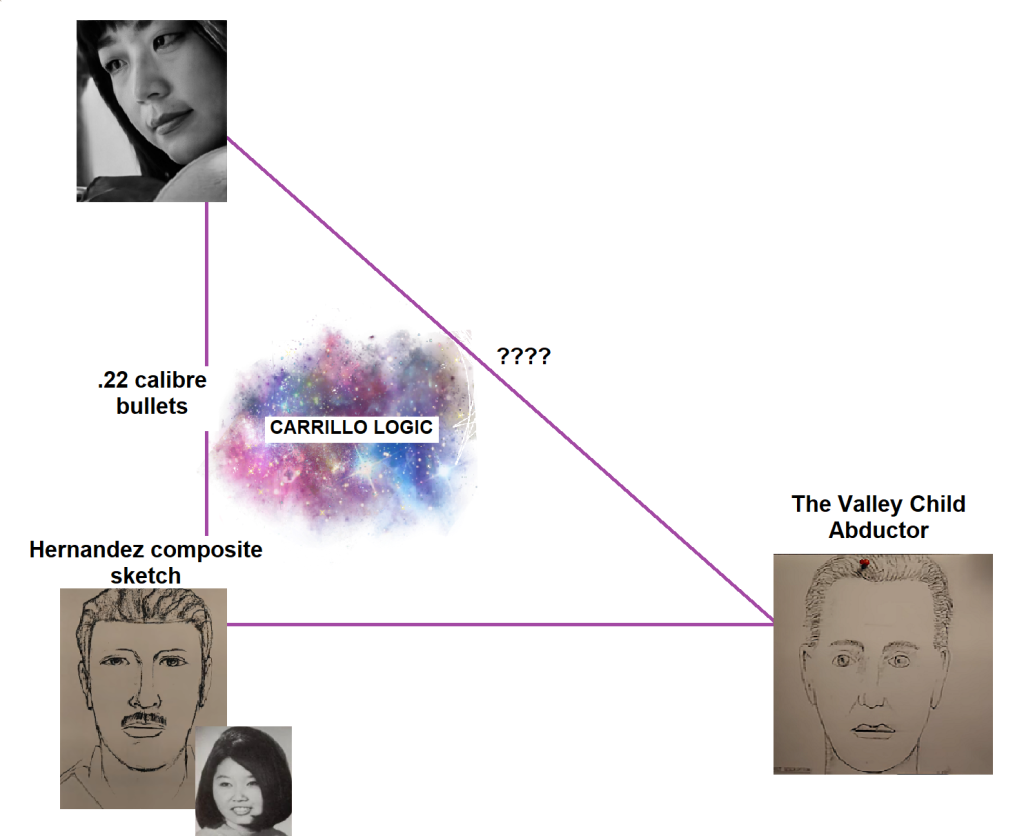
Digging through newspaper archives reveals this outrageous falsehood. Carrillo maintains this nonce claim to this day – and he is believed.
Utter Nonce-sense
On 14th March 1985, the Los Angeles Times reported that a little boy was abducted from his Monterey Park home late at night and sexually abused and abandoned. A similar kidnapping happened with a little girl in Montebello – but she was taken from her school. Days later, an adult witnessed a man trying and failing to lure a 12-year-old into his car. The article revealed he had “dirty-blondish hair”.

This one is from 29th March 1985. “Dark blond hair, about 5 feet 9 inches tall.”

Fear in their Eyes
In addition to the bullets and the questionable police sketches, Detective Carrillo created his ‘eye-contact theory.’ He believes that in both the Okazaki and Yu cases, the killer wanted to see fear in the victim’s eyes and that he took steps to make them face him. This hypothesis does not stand up by the time of the third incident, nor the four rape attacks as explained in this post (more details will be given in our book).
That third incident was the Zazzara double murders. Maxine Zazzara infamously had her eyes removed. Carrillo was not assigned to this case, but other detectives showed him the shoeprints at the scene. They appeared to be similar to prints found at the location where a child victim had been abandoned, nine days earlier. Carrillo was already developing a link between Okazaki, Yu and the paedophile. This only cemented his belief. This is confirmation bias.
Somebody from the Los Angeles County Sheriff’s Department (LASD) asked a firearms officer to compare projectiles fired at the Zazzara scene to those extracted from Okazaki and Yu.

The guns could not be conclusively linked. But note the date: 3rd April 1985. This is very early to be attempting to link very different crimes. This demonstrates how Carrillo was creating a serial killer narrative from the start despite the lack of modus operandi.
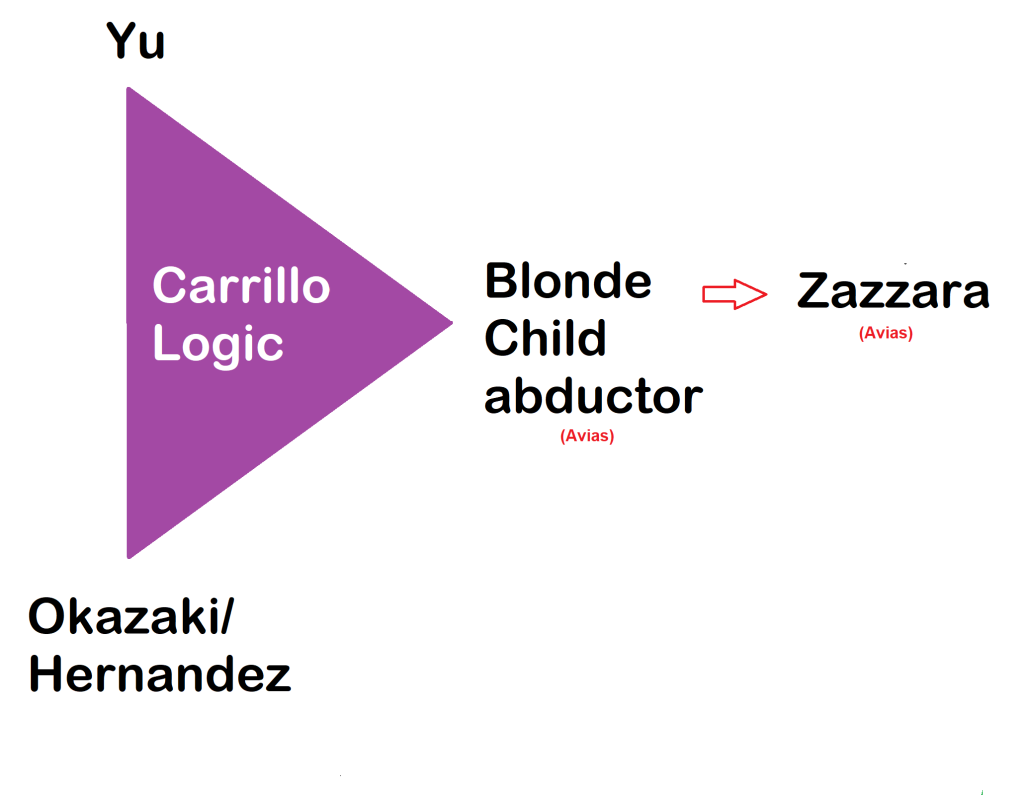
Arturo Robles
Arturo Robles was an early suspect. Carrillo was looking for a sexual deviant wearing exclusively black clothes even though one of the Yu witnesses said the killer wore light blue and Maria Hernandez told him her shooter wore a white shirt. Hernandez thought the killer was wearing a Members Only brand jacket and Robles owned one. He was a South Korea veteran who knew how to shoot. He collected adult magazines and had been cautioned by police for following young women.
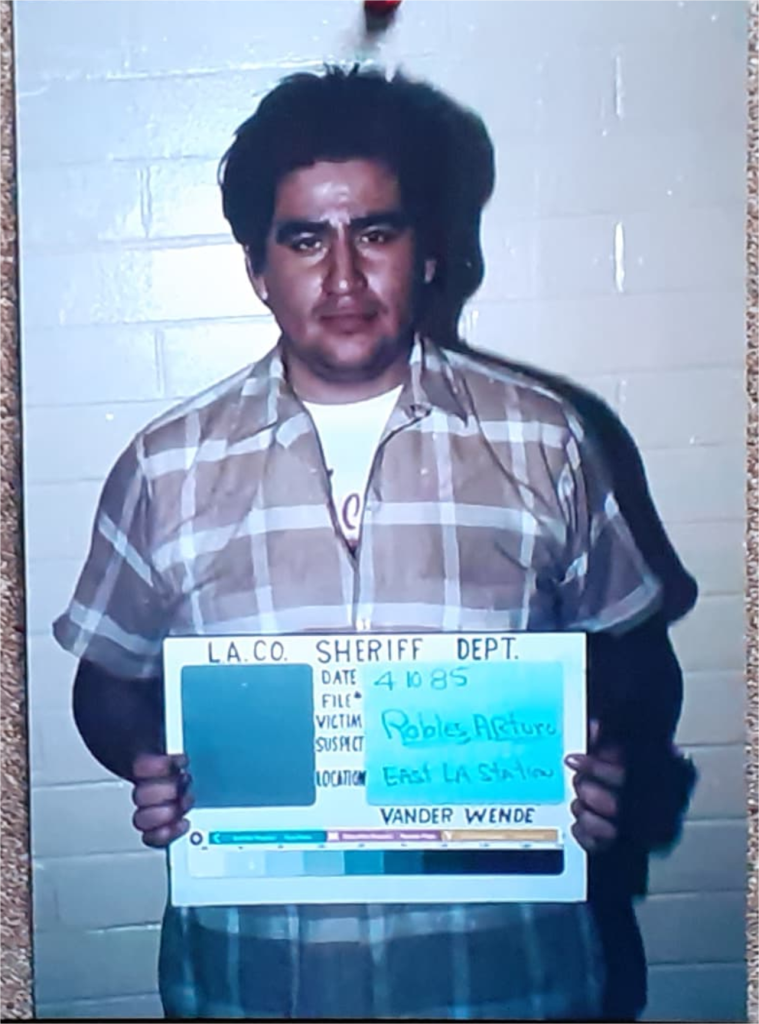
When Robles was taken to a police line-up, he heard someone uttering the words “serial killer”. According to author Philip Carlo, the Yu witnesses also had to view Arturo Robles at the line up – as did the kidnapped children. It was 10th April 1985 – before the main serial killer spree had started. None of these crimes shared characteristics and it was completely unreasonable to assume they had one perpetrator. Robles was released but Carrillo refused to drop the matter and he showed his mugshot to another victim in July – Sophie Dickman.
The Dois were attacked on 14th May. Because they lived in Monterey Park, they were attended to by the local police department. According to Philip Carlo, Monterey Park detectives made Gil Carrillo feel unwelcome because nobody had called the Sheriff’s Homicide Bureau. Shoe prints at this scene looked similar to those at the Zazzara house. One must ask why Carrillo was interfering at crime scenes that had nothing to do with him.
‘Richard Mena‘
On 30th May 1985, Mabel Bell and Florence Lang were badly beaten and pentacles were drawn on the wall and on Bell’s leg. On 15th June, Richard Ramirez was pulled over by police after jumping a stop sign near the Glendale Freeway ramp. When the officer turned to retrieve his citation book, Ramirez scarpered, but not before drawing a pentacle on his stolen car. Unbeknownst to him, this would make him a suspect. According to Philip Carlo, Gil Carrillo was studying police teletypes and read about this rather innocuous traffic incident. He believed the driver was on the run from another child abduction a few miles away. Again, this was confirmation bias. This is where Carrillo’s ‘man in black’ theory takes form.
The stolen car was impounded, and left in an LAPD lot in the baking June sun which melted any fingerprints away. A dental appointment card was found inside which revealed the driver was called ‘Richard Mena’. Both his name and address were fake and led nowhere. But now detectives had access to what they believed were the killer’s dental records. Stakeouts at the dentist’s surgery failed when the alarm malfunctioned. One has the impression that Carrillo and Salerno (LASD) have never forgiven the LAPD for this.
More Child Abductions
On 5th June, another child was abducted outside a school in Rosemead. Her description was sadly too vague to offer leads, but he was possibly Latino and dark-haired. However, on 27th June, another child was coaxed out of her bedroom, kidnapped, sexually abused and released wearing items of the rapist’s clothing. That girl was Anastasia Hronas from the Netflix documentary who said her short kidnapper had a Native American headdress tattoo on his arm. Carrillo corrected her and said she saw a pentagram. Ramirez did not have any tattoos.
The Spree: Late June to Early July
On 27th or 28th June, Patty Higgins was killed by slash wounds to her throat. Around this time, Gil Carrillo was partnered with a senior detective, Sergeant Frank Salerno. On 2nd July, Mary Cannon was beaten, stabbled and strangled and the Arcadia Police department, dealing with both attacks, gave it away to the LASD. An Avia print was found – although this is highly questionable. It was only when Whitney Bennett was almost strangled and beaten to death – and another Avia print was discovered – that Salerno began to believe Carrillo’s serial killer theory. However, with two victims dead and a third badly concussed, there was no suspect to report. Nonetheless, the media was starting to suspect there was a serial killer because Carrillo and Salerno were turning up all over the place.
On 7th July, there were two attacks in Monterey Park. Joyce Nelson was strangled and stomped to death in an horrific manner. A mile away, Sophie Dickman was robbed and sexually attacked. The inclusion of Dickman to the Night Stalker cases makes no sense, but because Sophie Dickman said her attacker had curly hair, he was assumed to be ‘Richard Mena.’
A composite sketch was released. The newspapers mistakenly labelled the rapist as the suspect in the Nelson murder. The suspects described in the Okazaki, Yu and Doi cases were fading away, soon to be replaced with the tall, curly-haired, pentagram-drawing car thief Richard Mena. The fact that Sophie Dickman reported a man of just 5’8″ to 5’9″ did not seem to matter. Facts were being altered to fit Carrillo’s serial killer theory, just as they had been since March 1985.
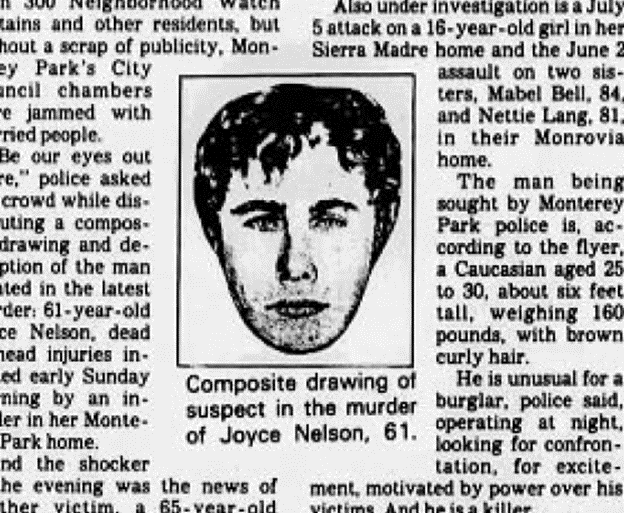
The Transfiguration of the Suspect
On 20th July, Maxson and Lela Kneiding were shot, and their throats cut. Then, 15 miles away, between 5 and 6:30am, Chainarong Khovananth was shot dead and his wife, Somkid, was raped and their son beaten and possibly molested. Somkid Khovananth gave a description of a light-skinned “Mexican” with stained, gapped teath. This is what the police were hoping for – somebody vaguely describing the mysterious ‘Richard Mena.’ Later, under cross-examination, Khovananth was compelled to admit she had previously described the killer as having a “brown face” or “dark skin.” She provided details for a police sketch and detectives made this image the definitive Night Stalker and claimed every victim had encountered somebody fitting this description.

Richard Ramirez was out in Los Angeles, living in stolen cars, clumsily burgling in the afternoon, selling stolen goods in a pool hall by night and shooting up cocaine, completely oblivious to the fact he had been implicated in a whole range of different crimes, just because he was in the wrong car at the wrong place at the wrong time. All police needed was his real name.
Chameleon Killer
On 6th August, in Northridge, Virginia and Christopher Petersen survived a shooting by tall man with dark curly hair combed back from his face. Then on 8th August, an attack similar to the Khovananth Incident took place in Diamond Bar. Survivor Sakina Abowath gave a description of a dark-blonde, curly haired white man between 6’2”-6’4” with a concave chest and “wide front teeth.” After the police asked her if his teeth had gaps, she replied that she did not remember. The next time the Night Stalker Task Force officers spoke to her, Abowath said they were “crooked and stained”, that his hair was changed to brown, and he now had “Latin features.” It suggests she was being led by police to say he matched the Khovananth composite. Abowath helped with her own drawing that has not been made public.
Pan and Carns
Two more crimes in San Francisco (17th or 18thAugust) and Orange County (25th August) were thought to be the work of the Night Stalker or ‘Richard Mena’ because of Satanic aspects. At the Carns house, rape survivor Inez Erickson claimed the attacker ordered her to say she loved Satan, similar to the Abowath Incident. At the Pan scene, a pentagram was carved into the wallpaper along with “JACK THE KNIFE.”
Ultimately, Ramirez was not tried for either case. However some circumstantial evidence was used to tie him to the Carns scene: a supposed partial fingerprint on an orange Toyota stolen – and found – in Los Angeles. However, as explained in this post, the car was seen more than a mile from the murder scene and there is no proof it was the same car. Inez Erickson did not see her attacker’s face and identified Ramirez from his walk. The Pan link will be discussed later in this post.
A Hypodermic Needle in a Festering Haystack
One might ask how – with all these differing descriptions and M.O.s – did the police link the crimes to Ramirez? Surely it was not simply the 15th June incident with the traffic violation and the pentagram? How did police find him if it was not him? After all, Los Angeles is teeming with criminals.
Our answer is that the police engineered the Night Stalker’s appearance. If police erase eyewitness descriptions and replace them all with their own theoretical suspect description – which was later confirmed by just one victim (Khovananth) – there is confirmation bias. Then they only have to convince vulnerable victims that they were mistaken, and the victims will change their description – possibly in deference to authority. This occurred with all victims and eyewitnesses in the Ramirez case.
An example of this is how the Night Stalker’s shadowy appearance is described by Carrillo: that he wore a black jacket, black trousers and black “rare, unique” shoes to conceal dried blood (which was never found on any clothes in Ramirez’s possession). Yet in the police reports, the suspect wore a range of clothes: a blue and multi-coloured shirt with brown pants, blue jeans, blue pants and a matching blue shirt, a mesh shirt, a brown and black checked shirt and a white top. The Night Stalker’s ‘kill kit’ and clothes are discussed here.
Informants in the North
By engineering the suspect’s description and disseminating a poster that misinformed the public that every survivor saw that person, it caused a snowball effect by which Ramirez’s acquaintances in two separate cities became police informants. This included the Greggs from Lompoc – Earl Gregg, an old roommate of Ramirez had received stolen goods from his mother-in-law, Donna Myers. (Read about the San Francisco friends here). These had come from a burglary in San Francisco on 15th June, three days before Peter Pan was found murdered. A fingerprint purportedly tied Ramirez to this burglary and so the SFPD insisted this separate crime proved he committed the murder. No fingerprints were found at the murder scene.
Ramirez’s ‘friend’ Armando Rodriguez gave up his name after being punched by SFPD Inspector Frank Falzon. Rodriguez attempted to give Ramirez an alibi, stating he had already left the city when Pan was killed and had been visiting San Francisco when the Los Angeles attacks occurred.
Informants in L.A.
Meanwhile, in Los Angeles, one of Ramirez’s associates, Alejandro Espinoza, reported his friend ‘Rick’ to the police. He said ‘Rick’ was a burglar, and sometimes sold to a fence named Felipe Solano. Combined with the reports of ‘Rick the burglar’ from Earl Gregg and his family, the police had a strong lead. (Read about these first informants here).
Ramirez was on the lowest rung of the criminal hierarchy there, and due to his lack of burglary skills and impulsivity, he was expendable; a liability. When Ramirez was named as the prime suspect, his friend Cuba became an informant, naming a few others. As covered in this post, felon Jesse Perez preposterously claimed Ramirez had confessed to a murder, but by this time, there was a financial incentive to report him – the two cities were offering financial awards, and snitches were offered immunity from prosecution.
Then finally, Felipe Solano had several stashes of stolen property, and claimed Richard Ramirez had given him all of it. Solano was possibly beaten by police to give up Ramirez’s name (according to the testimony of fellow burglar Sandra Hotckiss, covered in Philip Carlo’s Ramirez biography). Immune from prosecution, Solano was proven to have lied in court – he had received stolen property from others – but it made no difference to Ramirez’s convictions.
Police were unable to prove the chain of custody of any stolen item. No Ramirez fingerprints were found on any of the items. Nobody could prove he wore a pair of Avias to a murder scene.
After Ramirez’s arrest, he was charged with two more attacks – the throat slashing of Jennie Vincow on 28th June 1984, and the rape of Carol Kyle on 30th May 1985. Kyle assisted two artists with the creation of sketches. Her description of her attacker’s teeth did not match Ramirez. Moreover, her attack occurred at the same time as Bell and Lang’s – the aforementioned clock stopped at 05:29. The duration of Kyle’s attack was between 4 and 6am.
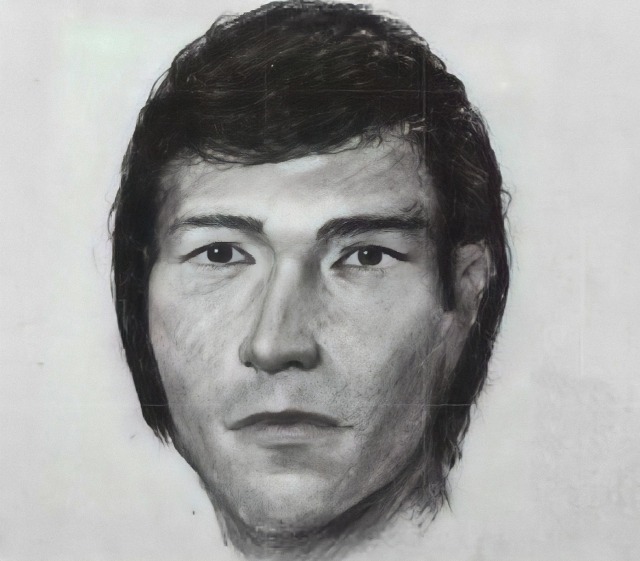
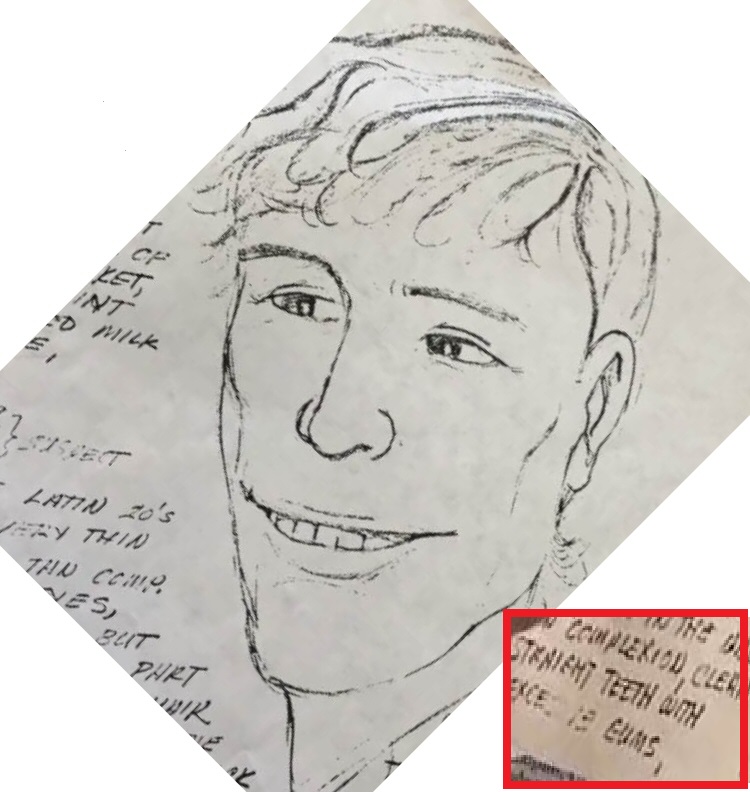
Hadsall and the Dropped Abduction Cases
To return once again to the child abduction cases, they were eventually dropped, with Ramirez’s defence claiming they were bogus and used to manipulate him into confessing. The prosecution and detectives claimed it was too harrowing for a child to relive their trauma. But the tenuous link between Okazaki to the rest of the crimes was all about the suspect’s facial similarity to the abductor, which in turn connected the shoeprints to the rest of the crimes. This was now broken. They needed another way to put the Avias on Ramirez’s feet.
Instead, the prosecution connected Okazaki to the Kneiding attack (with faulty ballistics evidence) and came up with a Monrovia burglary to link Ramirez to the Avia shoes – a full handprint was allegedly found close to the shoeprint.
This ‘Uncharged Incident’ is repeatedly referred to in the Petition. The witness, Clara Hadsall had conveniently passed away shortly after Ramirez was imprisoned, so there was nobody left to question. The Hadsall incident is questionable in itself and is covered here.
This is why Carrillo focuses on Okazaki and Yu so much – it was the paedophile’s link to the Avias. One could be forgiven for thinking Carrillo has grasped this idea with both hands and is still holding onto it as if it is his pension (which his ‘Killer Catcher’ fame technically is) – but the allegation that Richard Ramirez was the San Gabriel Nonce as well as the Night Stalker is ludicrous. How can anybody think a man who cannot even create an alias without using his own names was ever a criminal mastermind? But the concealment of Ramirez’s mental incompetence is a story for another day.
-VenningB-
3rd December 2022

Leave a comment